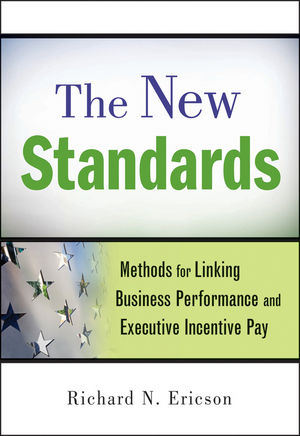The New Standards: Methods for Linking Business Performance and Executive Incentive PayISBN: 978-0-470-55989-5
Hardcover
336 pages
April 2010
 This is a Print-on-Demand title. It will be printed specifically to fill your order. Please allow an additional 10-15 days delivery time. The book is not returnable.
|
||||||
Preface ix
Acknowledgements xv
Chapter 1 To the CEO 1
Well-Designed Incentives Are Governance Defined 3
Old School 6
Act Now 7
You Do Not Run Your Company 9
The New Standards 10
It Is Not about You 14
Last Things First 16
Bottom Lines 17
Chapter 2 Business Valuation and Incentive Policy 19
The Rosetta Stone 20
Stealing the Playbook of Business Valuation 21
Incentives and Value Creation 25
Value is a Function of the Quality and Quantity of Earnings 28
Cost of Capital and Expected Returns 30
As Long as We’re at it 32
What Are We Paying For? 34
Total Business Return 37
The DCF Model Serves as a Proxy for Other Valuation Methods 40
Free Cash flow 43
FCF and the Irrelevance of Accounting Choices 45
Income and Capital: FCF’s Drivers Should Be the Main Incentive Drivers 46
The Shape of Things to Come 47
Quando, Quando, Quando 49
The Past is Relevant Only as Prologue 50
Valuation Perspective: Operational Results, Debt, and Capital Structure 52
Chapter 3 Market Practices in Incentive Pay 59
How Much Are We Paying for Management Incentives? 64
Variable Pay versus Incentive Pay 67
Mismatch Makers 74
Other Market-Based Considerations of Market-Based Consideration 75
Market Practices and Presumptions 77
Chapter 4 The New Standards 83
Common Sense 91
Bias is the Boil Weevil of Value Creation 92
Get Cynical 93
Incentivization and its Discontents 95
Leading Chartcter 97
Guidelines for Incentive Design 99
Chapter 5 Risk and Executive Incentive Pay 107
Risk Management Policy and Incentives 108
Sheep in Wolves’ Clothing 113
Investors versus Management 113
The Risk Trade 115
Risk and Incentive Calibration 119
The Wages of risk: Estimating the Cost of Capital 121
Beta Coefficients and the Capital Asset Pricing Model 121
Financial Leverage and the Cost of Capital 123
Other Methods and Evidence for Attaching a Cost to Capital 125
Chapter 6 Motive, Means, and Method: Evaluating Incentive Performance Metrics 131
Role of Individual Performance in Incentive Pay 132
Nonfinancial Goals 133
Evaluating Financial Metrics 137
Revenue, Volume, and Gross Margin 138
Using Valuation Criteria to Choose Metrics 141
Context for Evaluating Financial Metrics 142
Operating Income, EBIT, and Return on Invested Capital 143
Two Wrongs Can Make a Right 146
On the Importance of Being Earnest 149
Pretax Income, Net Income, EPS, and ROE 149
Debt, Share Repurchases, EPS, and Stock Price Gains 150
Remedying Issues with Pretax Income, Net Income, EPS, and ROE 154
Cash flow Metrics 155
Indexation and Immunity 158
Overall Perspectives 160
Chapter 7 Value-Based Performance Measures 163
Value-Based Measurement 165
Economic Profit or Economic Value Added 167
Use the Metric, Lose the Rest 169
Total Business Return 170
Shareholder Value Added 174
Cash Value Added 174
Cash Flow Return on Investment 175
Real Value Added 177
Common Values 179
Metric Adjustments and Business Governance 180
Metric Adjustments: Compulsories Only 185
Risk-Based Capital Requirements and Return on Economic Capital 188
How Not to choose Among Value-Based Metrics 191
Chapter 8 Ownership, Not Gamesmanship: Setting Targets and Ranges for Performance-Based Plans 195
Best of Both Worlds 196
Trifold guide to Benchmarks 197
The Past is Prologue 198
Not to Insult Chimpanzees 203
Interpreting the Oracle 205
Multiple Personalities 206
Full Reconciliation to Market Value 209
Setting Targets Based on Total Business Return 215
Run Away! 219
Range and Domain: setting Intervals for Performance and Pay 222
Weightings, Award Leverage, and Participant Influence 227
Incentive Risks, Calibration, and Testing 228
Chapter 9 Business Units and Private Companies, Phantom Stock and Performance Plans 231
Private Companies 233
Phantom Stock and Subsidiary Equity 234
Phantom Stock Plan Example Using Total Business Return 235
TBR Phantom Stock Grant Structure and Leverage 239
Dilution Guidelines and Competitive Award Levels 241
Valuation Approaches for the Phantom Stock Plan 242
Market Valuation Techniques 243
Discounts for Lack of Marketability and Control 244
Valuation Accuracy versus Incentive Efficacy 245
Reconciling and Funding Market Value and Formula Value 246
Market-Indexed and Performance-Based Valuation formulas 248
EBITDA as a Valuation Yardstick 251
Equity-Based Incentive Plans Based on Book Value 252
Tale of Three Cities 252
Adjusting Valuation Results 253
Performance Plans 254
Value-Based Incentives versus Private Equity Incentives 259
Where the Rubber Hits the Road 262
Chapter 10 Using Stock to Create Effective Incentives 265
From the Top 266
Off to the Races 269
Pros and Cons of Major Approaches to Stock-Based Incentive Design 271
All-In-One 273
Let Them Eat Risk 275
Purely Stock-Based LTI Approaches 278
Keeping the Horses in the Barn 280
Granting and Leverage 282
Equity-Based Incentives in Venture-Stage Companies 284
Ownership Effects 287
A Whole New Ball Game 287
Chapter 11 The Medium Is the Message 289
Incentive and Financial Governance 290
Human Resource Perspectives 293
Glossary 301
Index 305



